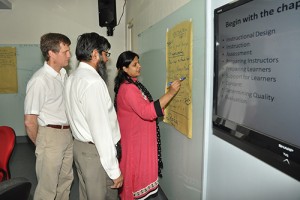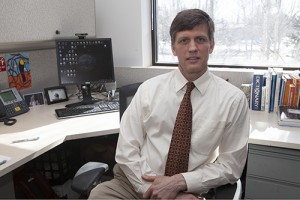Enhancing education in Pakistan
by Tracy Kalytiak |
International education development is Tim Jester's passion-the UAA education professor has spent countless hours in various countries, working with people to enhance the knowledge, skills and qualifications of teachers.

Dr. Tim Jester, an associate professor at UAA's College of Education, left, participated
in the USAID Teacher Education Project in Pakistan, in 2012-2013.
Photo by SEAMEO-INNOTECH/EDC.
He enjoyed a warm reception from educators in Pakistan when he traveled there four times in 2012-2013 as part of an invited USAID Teacher Education Project delegation, but with one key difference from conferences elsewhere-on their way to and from the congenial conferences, security officers inspected their cars, checking for bombs.
"It was just surreal," Jester said. "In the back of my mind I was always aware there was potential risk, but I didn't feel any threat. The people were extremely accommodating, welcoming."
Working at the macro and micro levels
Jester was visiting Pakistan to help educators in that country achieve goals of a five-year nationwide effort to improve the quality of teacher education and training for primary school teachers. This is especially important in Pakistan, where basic literacy, especially for girls, is a challenge nationwide-74 percent of males in Pakistan are considered literate, compared to 50 percent of females.
Their tasks included working at the policy level to create consistent, higher-quality teacher education requirements and curriculum throughout the country, upgrading the qualifications of teachers working in classrooms across Pakistan and providing support to Pakistan's Higher Education Commission and provincial departments of education, colleges and universities in developing new degree programs for those "inservice" teachers (as opposed to "preservice" teachers, who are individuals preparing to become teachers for the first time).
"There were multiple programs," Jester explained. "There wasn't a lot of coherence in the system to becoming a teacher. It didn't require the level of academic preparation they are now wanting. It wasn't uncommon for teachers to have one year of education beyond secondary school, then put in classrooms."
USAID funded the reform, and the Education Development Center and Teachers College of Columbia University implemented it.
The project staff traveled outside the country to see teacher education models in the Philippines and learn more about how they were constructed and functioned. They also crafted a degree program for inservice teachers who needed to upgrade their qualifications based on national teacher standards and a newly designed undergraduate teacher education program.
"These degrees are unique in Pakistan because they are based on current teacher education research and national teacher standards and require pre-service teachers to complete extensive academic and professional preparation," Jester said. "My work was to begin upgrading practicing teachers' qualifications that had not completed the newly developed degree programs."

Dr. Tim Jester, an associate professor in UAA's College of Education, took part in a USAID effort to devise higher-quality training and curriculum for teachers in Pakistan. Photo by Philip Hall/University of Alaska Anchorage
Jester worked closely with people in areas throughout Pakistan-from tribal areas in the west to the cities of Karachi, Islamabad and Lahore-addressing a challenge related to the Pakistani government's effort to achieve universal primary education, one of eight goals established after the United Nations Millennium Summit in 2000. All 189 UN member states and at least 23 international organizations agreed to achieve the goals by 2015.
As these development goals were pursued, "there was an increase in enrollment of primary-school children," Jester said. "As enrollment increased, there weren't enough teachers. Then it became an issue of quality of improving the quality of teachers."
Jester's group created a pilot model; universities in two provinces are implementing the group's work. The next step is providing a model showing exactly how the country's teachers needing to upgrade qualifications can do so.
Hurdling political obstacles
The U.S. Embassy in Pakistan routinely cautions visitors to avoid Western-oriented hotels and restaurants and vary their times and routes when traveling anywhere in Pakistan. Jester's work on the project and his four visits to Pakistan occurred during a particularly sensitive period.
• Highly unpopular U.S. drone flights continued in the northwest area of Pakistan, killing civilians as well as military targets.
• A new U.S. ambassador to Pakistan took office.
• U.S.-led NATO forces opened fire at two checkpoints on the Pakistan-Afghanistan border in November 2011, touching off seven months of unrest that ended with a U.S. apology and Pakistan's reopening of the two NATO supply routes leading into Afghanistan from Pakistan.
• In October 2012, a Taliban gunman shot 15-year-old Malala Yousafzai on her school bus in the northwest Pakistani province of Swat-the Taliban vehemently oppose education for females and Malala ignited their fury by publicly voicing her support for education opportunity for girls and women.
• Gun and bomb attacks killed 20 people during the national elections in Pakistan-May 11, 2013. Political violence ended the lives of 130 people throughout the campaign season; the most serious attack targeted a pro-U.S. political party in Karachi.
"I didn't know what to expect," Jester said. "The uncertainty was the most challenging part of the preparation, hearing the stories, the stereotypes, knowing that on the ground it was likely very different. The ambiguity was unnerving until I arrived and could start the work."
Life 'on the ground' in Pakistan
Despite the every-day bomb sweeps, driver and security measures, however, life in Pakistan seemed vastly different from the chaos the media often depicts, Jester said.
"Life goes on, is what we found," he said. "People tend to their daily activities."
One incident occurred-but it stemmed from temperature, rather than global politics or local extremists.
"It was 110 degrees and electricity was turned off," he said. "There was a protest with mostly young kids, teens or younger, blocking the highway. The driver tried to get through the group. They were throwing rocks. That's the most real experience we had with the risk, but it ostensibly had nothing to do with the larger political environment-it had to do with daily electrical outages, which are a major problem."
Jester found Pakistan fascinating, even in the nondescript residential areas where the education reform meetings took place.
Toyotas could be seen everywhere, Jester added.
"There are a lot of diplomats, international projects going on," he said. "Keep a low profile, that's one of the mantras, so a lot of them drive around in Camrys."
"I really loved the food, the spices," he continued. "I'd never been in an Islamic country. There were mosques, and they broadcast a call to prayer several times a day, often starting at 4 or 5 in the morning. The people [involved in the education project], many of them had their prayer rugs in the yard where the project was housed, doing prayers."
The people Jester met provided the highlight of his trips to Pakistan.
"They were open and welcoming to me, committed to the role education can play," he said.
Written by Tracy Kalytiak, UAA Office of University Advancement.
 "Enhancing education in Pakistan" is licensed under a Creative Commons Attribution-NonCommercial 4.0 International License.
"Enhancing education in Pakistan" is licensed under a Creative Commons Attribution-NonCommercial 4.0 International License.














